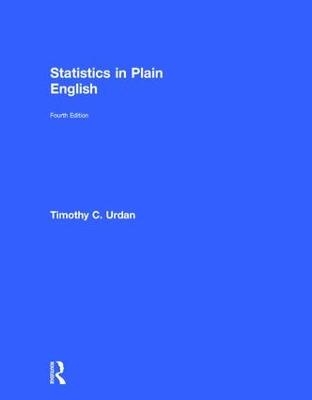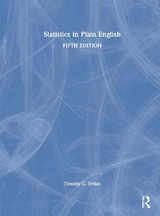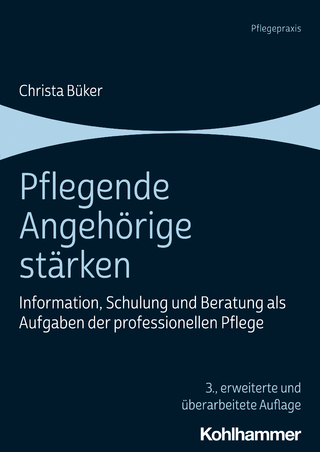
Statistics in Plain English
Seiten
2016
|
4th edition
Routledge (Verlag)
978-1-138-83833-8 (ISBN)
Routledge (Verlag)
978-1-138-83833-8 (ISBN)
- Titel erscheint in neuer Auflage
- Artikel merken
Zu diesem Artikel existiert eine Nachauflage
This inexpensive text provides an accessible overview of statistics to help readers gain a better understanding of how they work and how to interpret them correctly. Each chapter describes a technique, ranging from basic concepts like central tendency to advanced concepts such as t tests, ANOVA, regression, and factor analysis.
This introductory textbook provides an inexpensive, brief overview of statistics to help readers gain a better understanding of how statistics work and how to interpret them correctly. Each chapter describes a different statistical technique, ranging from basic concepts like central tendency and describing distributions to more advanced concepts such as t tests, regression, repeated measures ANOVA, and factor analysis. Each chapter begins with a short description of the statistic and when it should be used. This is followed by a more in-depth explanation of how the statistic works. Finally, each chapter ends with an example of the statistic in use, and a sample of how the results of analyses using the statistic might be written up for publication. A glossary of statistical terms and symbols is also included. Using the author’s own data and examples from published research and the popular media, the book is a straightforward and accessible guide to statistics.
New features in the fourth edition include:
sets of work problems in each chapter with detailed solutions and additional problems online to help students test their understanding of the material
new "Worked Examples" to walk students through how to calculate and interpret the statistics featured in each chapter
new examples from the author’s own data and from published research and the popular media to help students see how statistics are applied and written about in professional publications
many more examples, tables, and charts to help students visualize key concepts, clarify concepts, and demonstrate how the statistics are used in the real world
a more logical flow, with correlation directly preceding regression, and a combined glossary appearing at the end of the book
a Quick Guide to Statistics, Formulas, and Degrees of Freedom at the start of the book, plainly outlining each statistic and when students should use them
greater emphasis on (and description of) effect size and confidence interval reporting, reflecting their growing importance in research across the social science disciplines
an expanded website at www.routledge.com/cw/urdan with PowerPoint presentations, chapter summaries, a new test bank, interactive problems and detailed solutions to the text’s work problems, SPSS datasets for practice, links to useful tools and resources, and videos showing how to calculate statistics, how to calculate and interpret the appendices, and how to understand some of the more confusing tables of output produced by SPSS
Statistics in Plain English, Fourth Edition is an ideal guide for statistics, research methods, and/or for courses that use statistics taught at the undergraduate or graduate level, or as a reference tool for anyone interested in refreshing their memory about key statistical concepts. The research examples are from psychology, education, and other social and behavioral sciences.
This introductory textbook provides an inexpensive, brief overview of statistics to help readers gain a better understanding of how statistics work and how to interpret them correctly. Each chapter describes a different statistical technique, ranging from basic concepts like central tendency and describing distributions to more advanced concepts such as t tests, regression, repeated measures ANOVA, and factor analysis. Each chapter begins with a short description of the statistic and when it should be used. This is followed by a more in-depth explanation of how the statistic works. Finally, each chapter ends with an example of the statistic in use, and a sample of how the results of analyses using the statistic might be written up for publication. A glossary of statistical terms and symbols is also included. Using the author’s own data and examples from published research and the popular media, the book is a straightforward and accessible guide to statistics.
New features in the fourth edition include:
sets of work problems in each chapter with detailed solutions and additional problems online to help students test their understanding of the material
new "Worked Examples" to walk students through how to calculate and interpret the statistics featured in each chapter
new examples from the author’s own data and from published research and the popular media to help students see how statistics are applied and written about in professional publications
many more examples, tables, and charts to help students visualize key concepts, clarify concepts, and demonstrate how the statistics are used in the real world
a more logical flow, with correlation directly preceding regression, and a combined glossary appearing at the end of the book
a Quick Guide to Statistics, Formulas, and Degrees of Freedom at the start of the book, plainly outlining each statistic and when students should use them
greater emphasis on (and description of) effect size and confidence interval reporting, reflecting their growing importance in research across the social science disciplines
an expanded website at www.routledge.com/cw/urdan with PowerPoint presentations, chapter summaries, a new test bank, interactive problems and detailed solutions to the text’s work problems, SPSS datasets for practice, links to useful tools and resources, and videos showing how to calculate statistics, how to calculate and interpret the appendices, and how to understand some of the more confusing tables of output produced by SPSS
Statistics in Plain English, Fourth Edition is an ideal guide for statistics, research methods, and/or for courses that use statistics taught at the undergraduate or graduate level, or as a reference tool for anyone interested in refreshing their memory about key statistical concepts. The research examples are from psychology, education, and other social and behavioral sciences.
Timothy C. Urdan is a Professor of Psychology at Santa Clara University.
1. Introduction to Social Science Research and Terminology. 2. Measures of Central Tendency. 3. Measures of Variability. 4. The Normal Distribution. 5. Standardization and z Scores. 6. Standard Errors. 7. Statistical Significance, Effect Size, Confidence Intervals. 8. t Tests. 9. One-Way Analysis of Variance. 10. Factorial Analysis of Variance. 11. Repeated-Measures Analysis of Variance. 12. Correlation. 13. Regression. 14. The Chi-Square Test of Independence. 15. Factor Analysis and Reliability Analysis: Data Reduction Techniques. Appendices.
| Erscheinungsdatum | 24.05.2016 |
|---|---|
| Zusatzinfo | 84 Tables, black and white; 90 Illustrations, black and white |
| Verlagsort | London |
| Sprache | englisch |
| Maße | 210 x 280 mm |
| Gewicht | 884 g |
| Themenwelt | Geisteswissenschaften ► Psychologie |
| Mathematik / Informatik ► Mathematik ► Statistik | |
| Pflege ► Studiengänge ► Pflegewissenschaft | |
| Sozialwissenschaften ► Pädagogik | |
| Sozialwissenschaften ► Soziologie ► Empirische Sozialforschung | |
| ISBN-10 | 1-138-83833-0 / 1138838330 |
| ISBN-13 | 978-1-138-83833-8 / 9781138838338 |
| Zustand | Neuware |
| Haben Sie eine Frage zum Produkt? |
Mehr entdecken
aus dem Bereich
aus dem Bereich
Praktische Pflegeausbildung kompetent gestalten
Buch | Softcover (2021)
Urban & Fischer in Elsevier (Verlag)
CHF 58,75
für Lehre und Praxis an Pflege- und Gesundheitsschulen
Buch | Softcover (2024)
Urban & Fischer in Elsevier (Verlag)
CHF 55,95
Information, Schulung und Beratung als Aufgaben der professionellen …
Buch | Softcover (2021)
Kohlhammer (Verlag)
CHF 44,75



